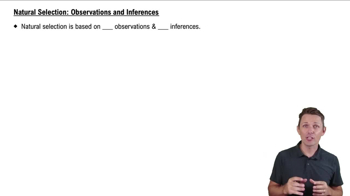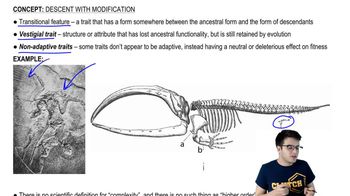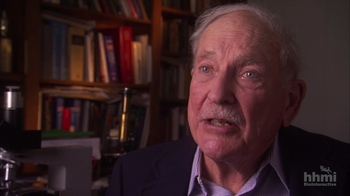Table of contents
- 1. Introduction to Biology2h 42m
- 2. Chemistry3h 40m
- 3. Water1h 26m
- 4. Biomolecules2h 23m
- 5. Cell Components2h 26m
- 6. The Membrane2h 31m
- 7. Energy and Metabolism2h 0m
- 8. Respiration2h 40m
- 9. Photosynthesis2h 49m
- 10. Cell Signaling59m
- 11. Cell Division2h 47m
- 12. Meiosis2h 0m
- 13. Mendelian Genetics4h 44m
- Introduction to Mendel's Experiments7m
- Genotype vs. Phenotype17m
- Punnett Squares13m
- Mendel's Experiments26m
- Mendel's Laws18m
- Monohybrid Crosses19m
- Test Crosses14m
- Dihybrid Crosses20m
- Punnett Square Probability26m
- Incomplete Dominance vs. Codominance20m
- Epistasis7m
- Non-Mendelian Genetics12m
- Pedigrees6m
- Autosomal Inheritance21m
- Sex-Linked Inheritance43m
- X-Inactivation9m
- 14. DNA Synthesis2h 27m
- 15. Gene Expression3h 20m
- 16. Regulation of Expression3h 31m
- Introduction to Regulation of Gene Expression13m
- Prokaryotic Gene Regulation via Operons27m
- The Lac Operon21m
- Glucose's Impact on Lac Operon25m
- The Trp Operon20m
- Review of the Lac Operon & Trp Operon11m
- Introduction to Eukaryotic Gene Regulation9m
- Eukaryotic Chromatin Modifications16m
- Eukaryotic Transcriptional Control22m
- Eukaryotic Post-Transcriptional Regulation28m
- Eukaryotic Post-Translational Regulation13m
- 17. Viruses37m
- 18. Biotechnology2h 58m
- 19. Genomics17m
- 20. Development1h 5m
- 21. Evolution3h 1m
- 22. Evolution of Populations3h 52m
- 23. Speciation1h 37m
- 24. History of Life on Earth2h 6m
- 25. Phylogeny2h 31m
- 26. Prokaryotes4h 59m
- 27. Protists1h 12m
- 28. Plants1h 22m
- 29. Fungi36m
- 30. Overview of Animals34m
- 31. Invertebrates1h 2m
- 32. Vertebrates50m
- 33. Plant Anatomy1h 3m
- 34. Vascular Plant Transport1h 2m
- 35. Soil37m
- 36. Plant Reproduction47m
- 37. Plant Sensation and Response1h 9m
- 38. Animal Form and Function1h 19m
- 39. Digestive System1h 10m
- 40. Circulatory System1h 57m
- 41. Immune System1h 12m
- 42. Osmoregulation and Excretion50m
- 43. Endocrine System1h 4m
- 44. Animal Reproduction1h 2m
- 45. Nervous System1h 55m
- 46. Sensory Systems46m
- 47. Muscle Systems23m
- 48. Ecology3h 11m
- Introduction to Ecology20m
- Biogeography14m
- Earth's Climate Patterns50m
- Introduction to Terrestrial Biomes10m
- Terrestrial Biomes: Near Equator13m
- Terrestrial Biomes: Temperate Regions10m
- Terrestrial Biomes: Northern Regions15m
- Introduction to Aquatic Biomes27m
- Freshwater Aquatic Biomes14m
- Marine Aquatic Biomes13m
- 49. Animal Behavior28m
- 50. Population Ecology3h 41m
- Introduction to Population Ecology28m
- Population Sampling Methods23m
- Life History12m
- Population Demography17m
- Factors Limiting Population Growth14m
- Introduction to Population Growth Models22m
- Linear Population Growth6m
- Exponential Population Growth29m
- Logistic Population Growth32m
- r/K Selection10m
- The Human Population22m
- 51. Community Ecology2h 46m
- Introduction to Community Ecology2m
- Introduction to Community Interactions9m
- Community Interactions: Competition (-/-)38m
- Community Interactions: Exploitation (+/-)23m
- Community Interactions: Mutualism (+/+) & Commensalism (+/0)9m
- Community Structure35m
- Community Dynamics26m
- Geographic Impact on Communities21m
- 52. Ecosystems2h 36m
- 53. Conservation Biology24m
21. Evolution
Introduction to Evolution and Natural Selection
Problem 1`
Textbook Question
Which of the following is not an observation or inference on which natural selection is based?
a. There is heritable variation among individuals.
b. Poorly adapted individuals never produce offspring.
c. Species produce more offspring than the environment can support.
d. Only a fraction of an individual's offspring may survive.
 Verified step by step guidance
Verified step by step guidance1
Understand the concept of natural selection: Natural selection is a process where organisms better adapted to their environment tend to survive and produce more offspring. This concept is based on observations and inferences about variation, competition, and survival.
Review the principle of heritable variation: Natural selection relies on the presence of heritable variation among individuals in a population. This means that traits can be passed from parents to offspring, allowing for evolutionary change over generations.
Consider the role of overproduction: Many species produce more offspring than the environment can support. This leads to competition for resources, as not all offspring can survive to adulthood.
Evaluate the survival of offspring: In natural selection, only a fraction of an individual's offspring may survive to reproduce. This is due to limited resources and environmental pressures, which select for individuals with advantageous traits.
Analyze the statement about poorly adapted individuals: Natural selection does not imply that poorly adapted individuals never produce offspring. Instead, it suggests that they are less likely to survive and reproduce compared to well-adapted individuals. This statement is not a foundational observation or inference of natural selection.
 Verified video answer for a similar problem:
Verified video answer for a similar problem:This video solution was recommended by our tutors as helpful for the problem above
Video duration:
55sPlay a video:
Was this helpful?
Key Concepts
Here are the essential concepts you must grasp in order to answer the question correctly.
Heritable Variation
Heritable variation refers to the genetic differences among individuals within a population that can be passed from one generation to the next. This variation is crucial for natural selection, as it provides the raw material for evolutionary change. Without genetic diversity, populations cannot adapt to changing environments, making them vulnerable to extinction.
Recommended video:

Sources of Genetic Variation
Overproduction of Offspring
Overproduction of offspring is a concept where species tend to produce more offspring than the environment can support. This leads to competition for limited resources, such as food and shelter. The excess offspring create a struggle for survival, where only the fittest individuals are likely to survive and reproduce, driving the process of natural selection.
Recommended video:

Natural Selection: Observations and Inferences
Survival of the Fittest
Survival of the fittest is a principle of natural selection where individuals with traits better suited to their environment are more likely to survive and reproduce. This concept does not imply that poorly adapted individuals never produce offspring, but rather that they are less likely to pass on their genes compared to well-adapted individuals. Over time, this leads to the prevalence of advantageous traits in the population.
Recommended video:

Evolution and Natural Selection

 4:58m
4:58mWatch next
Master Evolution and Natural Selection with a bite sized video explanation from Jason
Start learningRelated Videos
Related Practice































